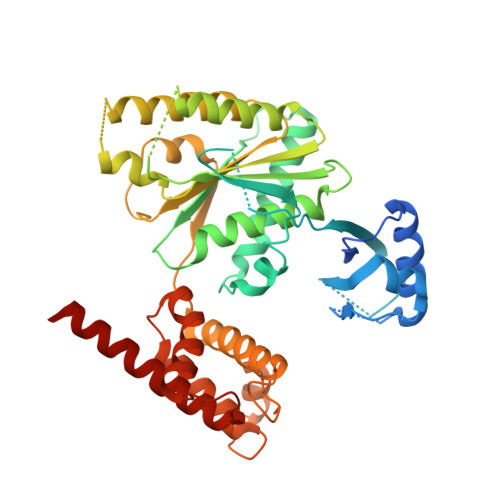The AAA+ ATPase TRIP13 remodels HORMA domains through N-terminal engagement and unfolding.
Ye, Q., Kim, D.H., Dereli, I., Rosenberg, S.C., Hagemann, G., Herzog, F., Toth, A., Cleveland, D.W., Corbett, K.D.(2017) EMBO J 36: 2419-2434
- PubMed: 28659378
- DOI: https://doi.org/10.15252/embj.201797291
- Primary Citation of Related Structures:
5VQ9, 5VQA - PubMed Abstract:
Proteins of the conserved HORMA domain family, including the spindle assembly checkpoint protein MAD2 and the meiotic HORMADs, assemble into signaling complexes by binding short peptides termed "closure motifs". The AAA+ ATPase TRIP13 regulates both MAD2 and meiotic HORMADs by disassembling these HORMA domain-closure motif complexes, but its mechanisms of substrate recognition and remodeling are unknown. Here, we combine X-ray crystallography and crosslinking mass spectrometry to outline how TRIP13 recognizes MAD2 with the help of the adapter protein p31 comet We show that p31 comet binding to the TRIP13 N-terminal domain positions the disordered MAD2 N-terminus for engagement by the TRIP13 "pore loops", which then unfold MAD2 in the presence of ATP N-terminal truncation of MAD2 renders it refractory to TRIP13 action in vitro , and in cells causes spindle assembly checkpoint defects consistent with loss of TRIP13 function. Similar truncation of HORMAD1 in mouse spermatocytes compromises its TRIP13-mediated removal from meiotic chromosomes, highlighting a conserved mechanism for recognition and disassembly of HORMA domain-closure motif complexes by TRIP13.
Organizational Affiliation:
Ludwig Institute for Cancer Research, San Diego Branch, La Jolla, CA, USA.














